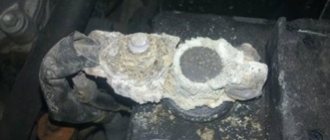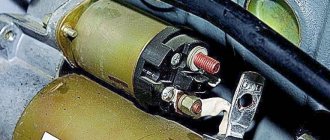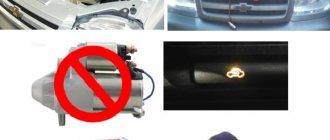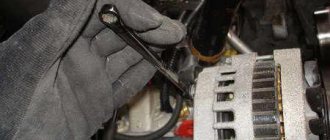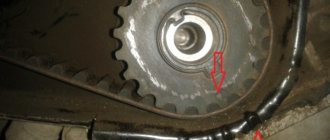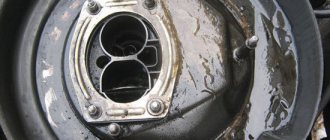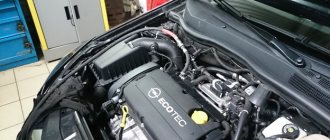If the cabin smells of gasoline when you start the engine, this is an alarm bell.
Let us note right away that there are many reasons why the smell of gasoline appears in the cabin when starting the engine. Among them there are both absolutely harmless (for example, supplying a rich mixture during a cold start) and alarming ones, for example, associated with a leaky fuel line. Only professional diagnostics will help determine the exact cause.
If you notice a smell in the cabin when starting a cold engine, then do not rush to worry. The fact is that when starting “cold,” the computer artificially enriches the mixture to make starting easier. Perhaps this is the only reason. However, it would be a good idea to inspect all hoses and connections of the fuel line for leaks. Start by checking the area under the car. Due to sudden temperature changes, pipes and hoses may crack. A fuel leak is accompanied by a characteristic “puddle”.
The presence of gasoline stains under the car indicates a leak.
The smell of gasoline when starting the engine: the main reasons
Let's start with the fact that during the operation of the vehicle, drivers in some cases note the appearance of a distinct smell of gasoline in the cabin or while being near the car.
In this article we will talk about why there is a smell of gasoline in the cabin when starting the engine or a smell of fuel when standing near a car with the internal combustion engine running or turned off, as well as what the driver should do if such a malfunction is detected.
The car smells like gasoline after refueling.
Let's start with, perhaps, banal, but not for all obvious reasons. The first situation was when you smelled gasoline in the car after visiting a gas station where there was no gas station attendant. That is, you filled the tank with fuel yourself. In such a case, it is advisable to have some disposable gloves in the trunk so that you do not have to take the “gun” with your bare hands. Of course, no one monitors its sterility. Therefore, it is quite logical that after refueling yourself, your hands will stink of gasoline for a long time.
The second situation - there was a gas station attendant, but the circumstances were such that, in addition to the neck of the tank, gasoline also got onto its “surroundings” - on the hatch, lid, body... In such cases, even if you did not touch all of the above, the smell of gasoline may leak into the car interior through open windows.
Both situations are as banal as they are harmless. You can wash your hands, and drops and smudges of gasoline in the area of the filler neck will quickly evaporate, and will not bother you with an unpleasant odor in the cabin for a long time.
There is a smell of gasoline in the car: reasons
So, let us immediately note that the smell of gasoline in a car may not appear all the time, but only under certain conditions. For example, in severe frosts or heat, when a cold engine is just starting or after the power unit has warmed up, when filling a full gas tank, etc.
In any case, it is necessary to establish the reason why the odor occurs. Note that in some cases it is quite difficult to quickly solve the problem. It is necessary to check the elements of the fuel system step by step.
- First of all, you need to start diagnosing with the gas tank and its cap. The tank, especially on older cars, can rot. The tank mounts also suffer, as a result of which it begins to shift. Also, over time, welds, etc., become unusable.
The possibility of mechanical damage should also not be excluded. One way or another, even a minor leak will mean that fuel leaks out, filling the car interior with fumes, etc.
This valve is needed to avoid an increase in pressure in the tank during temperature fluctuations and expansion of gasoline with heating. If the valve is clogged or stuck, or there are problems with the sealing gasket of the cap, then a distinct smell of gasoline will appear.
- Let's move on. If everything is normal with the tank, then you need to inspect the fuel line, connections and clamps, and also check the integrity of the pipes. Along this line, gasoline is both supplied to the internal combustion engine (supply) and its excess is returned back to the tank (return).
Hoses may begin to leak, and the reliability of their fastenings will deteriorate. It is quite obvious that in this case a leak also occurs, and gasoline fumes will annoy the driver with the smell of fuel in the cabin.
The next element to check is the fuel pump. On cars with a carburetor, the fuel pump is often located under the hood or outside the tank. At the same time, on injection cars, the fuel pump is submersible (located in gasoline to extract fuel and cool), that is, it is actually “screwed” into the gas tank. As a rule, on many cars with an injector, the pump is located under the rear seat right inside the vehicle.
Fuel filters, especially if they are dirty and have reduced capacity, can also cause the smell of gasoline in the car. The reason is an increase in pressure in the fuel line, after which the joints of the pipes begin to leak; gasoline can flow at the “input” before or at the “outlet” after the filter itself.
To eliminate this cause, the fuel filter needs to be changed, and as part of further operation, select the correct element for a specific car and replace the filter according to the regulations, avoiding severe contamination of the filter element.
- The power supply system with a carburetor requires a separate check of this fuel supply system to the engine. Often, the carburetor requires adjustment, and its incorrect adjustment or malfunction of the device leads to gasoline overflowing.
Naturally, active evaporation of fuel in the engine compartment will cause gasoline vapors to enter the cabin. To prevent this from happening, it is necessary to properly adjust the fuel level in the float chamber, check the condition of the jets, regularly clean the carburetor, etc.
Injection problems
If you have a modern fuel-injected car, but the smell from the muffler appears like that of an old Volga
, therefore the fuel is re-enriched. One of the reasons for this is. Also on injection machines there is a valve that regulates the discharge of unused gasoline back into the gas tank. If it fails, the combustible mixture will be greatly over-enriched.
A faulty air mixture sensor creates the same problem. An experienced auto electrician will quickly fix these problems.
Do you have a modern car, but have you noticed that the exhaust pipe smells of gasoline? There is no need to panic, there is an explanation for this. A catalyst is installed in the exhaust pipe, which is required to clean and burn harmful substances and gasoline vapors found in the exhaust gases. But until the catalyst heats up to a temperature of 250°C, it does not clean anything.
Its operating temperature is 600-800°C
. That’s why Western experts recommend driving as soon as the car starts, so that the catalyst warms up faster.
Additionally, you should know that the lambda probe has practically no effect on a not warmed-up car. Therefore, the first minutes after starting the engine there is always an over-enriched mixture, which entails the smell of unburnt gasoline. After the car warms up, this unpleasant effect disappears.
This problem worries many motorists, because they are well aware that gasoline is not something to joke about. But another nuisance is added to this problem - fuel consumption increases. If such a problem is discovered, then the first thing to do is inspect the entire car body from the hood to the fuel tank. Sometimes it happens that the nut of the fitting connecting the fuel line to the carburetor becomes loose. The radiator fan blows gasoline vapors back to the muffler.
After discovering the cause of the malfunction, the car must be placed in an inspection hole and very carefully trace the path of the fuel from the fuel tank to the carburetor, and if the engine is fuel-injected, then to the injectors. It will be necessary to tighten all the fittings and clamps on the connecting hoses of the fuel line.
Often on domestic cars, after just 3-5 years of operation, the gas tank turns into a sieve. If during inspection no gasoline leaks were detected, then you should try to study this problem in as much detail as possible.
Why does it smell like gasoline when starting the engine “cold” or “hot”?
Note that if the smell of gasoline is heard only for some time after starting the injection engine, then this is not a malfunction in all cases. Often, the smell of fuel appears after a cold start in winter, then completely disappears as the power unit warms up. If this is the case, then you need to understand the following:
- The ECU receives information from the engine temperature sensor, which “reports” that the unit is cold.
- Based on this information, the control unit enriches the mixture, significantly, and also increases the speed to the so-called “warm-up” speed.
- When operating with an over-enriched mixture in the cylinders of a cold engine, the fuel does not burn completely; some of it ends up in the exhaust system.
Possible engine problems
Does the muffler smell like gasoline and is it not very comfortable to drive? Then, the first thing to do is to unscrew the spark plugs and try to understand in which of the cylinders the fuel does not burn and passes further through the exhaust manifold. The location of the gasoline leak will be indicated by a wet or greasy spark plug.
It is not uncommon for the chamfer of one of the exhaust valves in the combustion chamber to burn out. It is from there that the fuel-air mixture exits into the exhaust pipe. An experienced auto mechanic can help eliminate the penetration of the gasoline mixture.
It will be necessary to change the rings on the pistons, valves, and sometimes the pistons themselves. So, we can assume that the car owner is provided with an average repair of the power unit. However, there is no need to rush into repairs; first, it is better to diagnose the engine, because not everything is always so hopeless.
A poorly fitting spark plug cap or high voltage wire can cause the spark plug to operate intermittently. This may allow fuel to flow freely into the exhaust manifold. There is no need to be alarmed if some kind of liquid suddenly pours out of the muffler, because it is not fuel, but condensation formed on the walls of the muffler when starting the engine. Of course, it may smell like gasoline, but don’t worry, it’s not gasoline.
Tips and tricks
As a rule, in the event of a problem, it can be quite difficult to quickly determine why the exhaust pipe smells of gasoline, the smell of gasoline is detected when the windows are open, the smell of evaporating fuel is heard under the hood, in the cabin, etc. without proper experience. For this reason, it is optimal to deliver the car to a service station and show it to specialists who will inspect and perform computer diagnostics of the engine and its systems.
We also note that the situation when the smell of gasoline appears in the engine oil should deserve special attention. If the oil smells like gasoline, or you can hear a distinct smell of fuel coming from the oil filler neck, then the situation is serious. The cause is again incomplete combustion of the fuel, with unburned residues entering the lubrication system.
Most often, the most intense penetration of fuel into the oil occurs on a cold engine, since after warming up the fuel evaporates better and flows less intensively into the crankcase. In any case, the problem needs to be solved as soon as possible, since operating the engine with a gasoline-oil mixture in the lubrication system is highly not recommended.
Common motor problems
Does the exhaust pipe smell of gasoline and do you feel uncomfortable driving your car? The first step is to determine in which specific cylinder the fuel does not burn and is carried further along the exhaust manifold. A spark plug that is wet or has a greasy appearance than others will show you the main location of the gasoline leak.
If all the candles are evenly greased
, then open the oil filler neck and look at the condition of the oil and the presence of light brown foam on the neck cap. This foam indicates that because , the entire combustible mixture does not burn and fuel particles are carried away into the exhaust pipe.
If you have a compression gauge, this is easy to determine.
There are often cases
when the chamfer of one exhaust valve in the combustion chamber gradually burns out and through it the gasoline-air mixture constantly breaks into the exhaust pipe. An experienced mechanic will help eliminate gasoline leakage in it.
{banner_content} It is necessary to replace the piston rings, valves, and in advanced cases, the aluminum pistons themselves. That is, you are guaranteed an average engine repair. And yet, you shouldn’t rush into repairs at first.
Not everything is so bad
. A loose cap on the spark plug or a high-voltage spark plug wire with a breakdown will cause the spark plug to work intermittently, which will allow gasoline to flow freely into the exhaust manifold.
But don’t be alarmed if you see some kind of liquid pouring out of the muffler in a stream or drop by drop; this is not gasoline, but steam condensation that forms on the cold walls of the muffler when the engine starts. Although condensation can also smell like gasoline.
Let's sum it up
Taking into account the above information, it becomes clear that there are many reasons why the car smells of gasoline, the smell of fuel is heard from the exhaust pipe or under the hood.
Of course, there is always the possibility that the smell simply entered the cabin from another car while driving on the road. It is also quite possible that after starting a cold engine in cold weather, the ECU supplies an enriched mixture, which leads to the appearance of a fuel smell from the exhaust pipe before a certain warm-up.
Finally, we note once again that it is not recommended to operate the car if there is the slightest suspicion of fuel leaks until the problems are corrected, given the high probability of fire. Remember, gasoline is highly flammable, and gasoline vapors themselves are explosive!
The causes of whistling and increased noise during operation of the fuel pump are overheating of the pump. How to diagnose and fix the problem yourself. Tips and tricks.
Why is it necessary to clean the fuel pump mesh? When is it better to change and how to clean the fuel pump mesh? How to properly remove the fuel pump, subtleties and nuances.
What functions does the fuel pump relay perform, signs of breakdown. Where is the fuel pump relay installed, how to properly check the fuel pump relay.
How to determine why the fuel pump does not pump or works poorly. Fuel rail pressure, pump diagnostics. Wiring, relays, fuel pump fuses.
If you have water coming out of the exhaust
In most cases, if there is water coming out of your exhaust pipe, it should be accompanied by white smoke. This is a good thing as it can help you more easily identify your problem and fix it accordingly. Fortunately, in most cases, when water comes out of the exhaust pipes, it is not a problem, since only condensed water will form in the exhaust system (this usually happens on colder days).
You can confirm this if white smoke comes out of the exhaust pipe, it should be very thin and vapor-like. This problem can be easily resolved if you let the machine run for a few minutes (the smoke should become colorless) and if this happens, you have nothing to worry about.
On the other hand, if the car has been running for several minutes and the white smoke coming out of the exhaust pipe is very thick, it could become a more serious problem for your engine.
The car won't start - 5 most common reasons
Imagine getting into your car in the morning to go to work. And suddenly the car won't start. This situation can confuse many drivers. Why did this happen if everything was fine yesterday?
We've collected the 5 most common reasons why a car won't start and told you how to diagnose and fix the problem.
Problems of a modern engine
If you drive a modern fuel-injected car, and the Glushak “rushes” like an old Volzhana, we can conclude that the fuel is being over-enriched. The cause may be improper operation of the lambda probe. On fuel-injected cars there is a valve that regulates the discharge of unburned fuel back into the gas tank. If it breaks down, the gasoline will be very rich. A failed air mixture sensor can create a similar problem. An auto electrician will be able to “deal” with such a malfunction very quickly.
Dead battery
No matter how high-quality the battery is, it can fail unexpectedly. A battery acid battery runs out for the following reasons:
- The battery is old and has exhausted its service life;
- the generator is not in order - it has stopped charging the battery;
- one of the consumers in the car is faulty or connected to the battery incorrectly;
- unfavorable weather conditions - the battery often runs out in winter during severe frosts;
- the heating, music or lights were left on at night.
To check the battery condition, it is convenient to use a tester. When the battery is fully charged, the voltage at its terminals should be between 12.6 and 12.7 V. If, when checking, the value is lower, it’s time to charge the battery.
When you don’t have time to charge, but you need to go urgently, use the old method - “light it” from another car by connecting wires with clamps from the battery of a working car.
Car lighting diagram
After this, we recommend visiting a car service center as soon as possible for diagnostic purposes - it’s probably time to install a new battery, repair the generator or other devices in the car.
How to prevent liquid from appearing in the exhaust system of a car?
The likelihood of condensation forming does not depend on what kind of machine you have. You may be the owner of an old penny or a luxury car, but you are unlikely to be able to resist the laws of nature. However, there are ways to minimize the harmful effects if you follow a few simple rules.
- Don't be lazy about putting your car in the garage. Often in cold weather, drivers do not want to walk the extra distance from the garage to the house and leave the car right on the street. Don't do this if you feel sorry for your iron horse. If the car spends the night in a warmer room, it will have to warm up much less the next morning.
- Some cars have an automatic warm-up function. It turns on independently at a certain period of time. However, even with such a system, the next day there may be ice in the pipe. This means that the warm-up time is simply not enough for the muffler itself to warm up. The metal still remains cold and promotes condensation. There is a way out of this situation: simply increase the operating time of the heating system.
- If it is not possible to park the car in a garage or use the automatic heating function, insulate the muffler itself. A non-flammable heat insulator or liquid heating will help you with this.
- Change your gas station: Your fuel may not be as high quality as you think. Often this method helps, if not completely get rid of it, then at least reduce the amount of moisture formed.
Faults in electrical wiring. Loose high voltage clamps
Pay attention to the electrical wiring, check all connections and terminals. They tend to oxidize, causing loss of electrical connection.
To eliminate such malfunctions, it is enough to clean the problem areas with sandpaper or a brush. There are also special lubricants for this, which are sold in any car store.
Even clean contacts can weaken over time from constant microvibrations. Move the terminals and, if necessary, tighten them for stronger contact.
Sometimes the clamps of the wires that connect to the battery also become loose. The first sign is a greenish or white coating around the contacts.
Oxidized battery contacts
Carefully remove the clips from the battery without touching the deposit with your hands - this is an acidic environment. Then use a wire brush to clean the contacts. If you don’t have a brush at hand, you should at least tap the oxidized area with a wrench so that some of the dirt falls off. All that remains is to restart the car - if the reason was dirty contacts, it should start.
Gasoline from the exhaust pipe
| Registered: Fri Oct 03, 2008 1:49 pmMessages: 29 | Motorcycle CB400 SF VTEC3 2004 |
| Registered: Fri Oct 03, 2008 1:49 pmMessages: 29 | |
| Registered: Sat Jan 26, 2008 9:56 pmMessages: 684 | |
| Registered: Fri Oct 03, 2008 1:49 pmMessages: 29 | That's how things are. I don’t know if I’ll start in the morning. |
Starter doesn't work
A starter is an electric motor that starts a car's engine. If, after turning the key or pressing a button, the starter does not turn and instead makes unpleasant sounds (grinding, clicking), it is most likely faulty.
- First of all, check whether the starter is connected to the battery correctly.
- After making sure that the contact is working properly, try honking the horn and turning on the headlights. If the sound is quiet and the light is dim, this indicates a low battery. And the starter has nothing to do with it. How to proceed is described in the section about a dead battery.
- If you find that both the headlights and the signal are working normally, we recommend disconnecting the wires from the ignition switch and trying to close them for a short time. If this is the problem, the car will start. All that remains is to return the wires to their place and go to a car service center.
- When the ignition switch is probably working properly, but the starter still does not work, the problem probably lies in the circuit between the starter traction relay and the battery. Take any additional wire, connect it with one end to the relay plug, and touch the positive terminal of the battery with the other. If the car starts, then you need to restore the wiring.
But it happens that none of the above methods helps, and the starter itself is broken. In this case, the smartest thing to do is call a tow truck and take the car to an auto electrician.
The smell of burnt wires
This may indicate problems with the vehicle's wiring. Despite the presence of many fuses, even they do not guarantee the prevention of short circuits. If the smell definitely comes from the car, it is recommended to inspect the car's wiring or contact a car service center.
If smoke appears, you must immediately perform the following actions:
- Stop the car.
- Turn off the ignition.
- Disconnect the terminals from the battery.
- Call a towing service and then head to a service center.
This problem should be solved as quickly as possible, since a car fire poses a danger to both you and other road users.
No fuel. Failures in the fuel system. Candles are flooded
There are many funny cases when a car does not start due to a banal lack of gasoline in the tank. We recommend that you first look at the sensor. Obviously, the solution is very simple - you need to refuel the car. But sometimes there is nothing funny about the fuel situation.
It happens that the lack of fuel is caused not by the driver’s forgetfulness, but by a leak that has formed. The first sign is the smell of gasoline in the cabin. If you feel it, carefully inspect the car and the ground underneath it for stains and puddles.
Leakage occurs for the following common reasons:
- the hose of the separator, a device in the fuel system responsible for cleaning the fuel from impurities, burst;
- the joints between the tank and the pipes have lost their tightness;
- a pipe burst at the filler neck;
- a crack has formed in the tank itself;
- The fuel pump gasket is worn out.
If a leak is detected under the fuel pump, it is enough to install a new seal. In other situations, as a rule, you need the help of specialists.
Another barrier to starting a car related to the fuel system is a problem with the fuel relay or pump. It’s easy to diagnose a breakdown, but you need silence.
If a peculiar buzzing sound is heard when the ignition is turned on, the relay is malfunctioning. If, on the contrary, there are no sounds, the reason is in the pump. But the absence of sounds may also indicate a break in the electrical circuit.
Diagnostic measures
How can a driver understand the causes of problems with the car’s exhaust system on his own?
- It is necessary to check the tightness of the pipes and the rocker boot. It is not recommended to touch the pipes with your hands - during operation of the power unit they have a high temperature. You can check for leaks by running your hand through the air.
- Sometimes it doesn't hurt to look in the trunk. Seals in station wagons and hatchbacks suffer from wear more often than in other car brands. Checking ventilation with check valves will give a positive result.
- In older cars, it is recommended to remove the plastic luggage “pocket”. Vehicles rust, and holes created during operation are another reason for the smell of exhaust gases to appear in the cabin and eliminate this problem.
You can patch the seals on the rear windows using Liquid Nails glue. Sometimes the car starts to smell like rotten eggs. What is this?
Candles
Another reason is spark plugs filled with gasoline, whose job is to ignite the fuel. If the elements are installed a long time ago, they gradually become dirty. Each automaker specifies the intervals for checking and replacing spark plugs in the maintenance schedule. In addition, the necessary information is indicated in the service book or in the vehicle’s operating manual.
Spark plug flooded with gasoline
When the driver tries repeatedly and unsuccessfully to start the car, the spark plugs become heavily flooded with gasoline. After that they definitely won't work anymore. To correct the situation, unscrew and dry them.
Candles can also be filled on a carburetor engine. But the described situation is especially relevant for modern cars with electronic injection, when the driver unknowingly begins to repeatedly press the gas pedal, which in this case only causes harm.
What is the danger of water in the muffler?
Natural transparent condensation is not a problem if there is little of it. It’s just water - its accumulation, on the contrary, indicates the serviceability of all systems. Things get worse if the moisture has an unusual color and thick black smoke appears.
Danger No. 1 - condensation can turn into ice. This threatens to rupture the muffler or resonator. In addition, when water freezes, important channels connecting the motor to other systems become clogged. Therefore, it is very difficult, almost impossible to start the car.
Danger #2 is corrosion. The internal cavities of the exhaust system quickly rust. For example, on the first VAZ cars, the resonators and pants rotted in almost 3 years, although they were made of durable steel. With a stainless muffler of foreign cars, things are somewhat better, but condensate can react with sulfur dioxide (present in the exhaust of any internal combustion engine), form acid and corrode the metal in 1-2 years.
Moisture is especially dangerous for a diesel unit. Here, fuel lines and fine filters easily freeze, and interruptions in the operation of glow plugs occur even in summer.
The color of the condensate coming out of the muffler is important. Yellow (or red) color indicates an antifreeze or oil leak. Black condensate is the use of low-quality fuel with additives. Also, black color indicates carbon deposits. The green tint is a consequence of the high sulfur content in gasoline.
The alarm system is faulty
Car alarms, like all electronic systems, are subject to failures:
- triggers randomly;
- does not set the car alarm;
- blocks disarming via the original key fob.
Finally, electronics sometimes prevent the car from starting. The reasons are as follows:
- the alarm wiring or its power line is faulty;
- The anti-theft device (immobilizer) does not work;
- they tried to steal the car;
- there was a problem in the program.
Sometimes the driver himself forgets to remove the car from the security system, which includes an ignition interlock. Remove the protection and start the engine.
To check whether the cause is really an alarm failure, pay attention to the following signs:
- The alarm indicator light does not flash as usual;
- the security system is disarmed, but the key fob still displays a message about the ignition switch being closed;
- The sound of the siren does not turn off, the light alarm goes off;
- buttons do not work correctly;
- The central unit does not respond to signals from the key fob.
Try resetting the alarm to factory settings via the key fob. The procedure is described in the instructions, which it is recommended to always keep in the glove compartment. If you don’t have it at hand, download it from the Internet.
If the central unit does not respond to key fob presses, reset by pressing the secret button - VALET. Most often, the VALET button is hidden under the dashboard or in other hidden places. Turn the ignition on, off and on again. Then press the secret button three times. Some systems require you to enter a PIN code.
